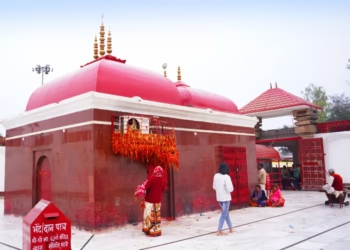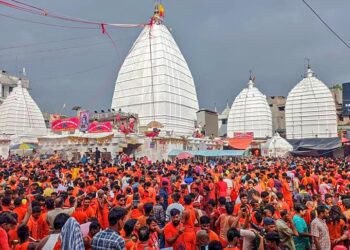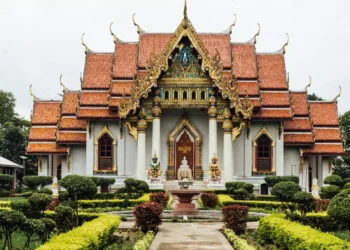Gujarat, a vibrant state in western India, is a treasure of ancient Hindu and Jain temples built by dynasties like the Solankis, Chaulukyas, and Vaghelas. These shrines, with their detailed carvings and grand designs, show Gujarat’s rich spiritual and cultural heritage. Below are fourteen key temples in Gujarat, each with its own history and divine charm, welcoming devotees and visitors from across India and beyond.
Somnath Temple, Prabhas Patan
On the Arabian Sea coast in Saurashtra, the Somnath Temple, from the 11th century, honors Lord Shiva as a Jyotirlinga. Rebuilt by Chaulukya king Bhimdev I, its Chalukya-style spire has carvings of Shiva with Nandi. Mahashivratri in February or March draws thousands for lamp offerings. Known as one of twelve Jyotirlingas, it’s a top pilgrimage site. Local tales say the moon god Soma built it, adding sacred aura.
Dwarkadhish Temple, Dwarka
In Dwarka, the Dwarkadhish Temple, from the 16th century, is dedicated to Lord Krishna as Dwarkadhish. Its five-story Nagara spire, built by the Vaghelas, shows Krishna with his flute. Janmashtami in August has bhajan nights. A Char Dham site, it draws lakhs. The temple’s riverside setting by the Gomti River feels holy. Stories link it to Krishna’s ancient kingdom.
Akshardham Temple, Gandhinagar
In Gandhinagar, the Akshardham Temple, built in 1992 by the Swaminarayan sect, honors Lord Swaminarayan. Its modern Nagara-style dome has carvings of deities, painted in pink and gold. Diwali in October or November hosts light shows. Known for its lush gardens, it’s a spiritual hub. The 7-foot idol glows with divine energy.
Modhera Sun Temple, Mehsana
Near Mehsana, the Modhera Sun Temple, from the 11th century, is dedicated to Lord Surya. Built by Solanki king Bhima I, its stepwell and chariot-shaped hall have carvings of Surya on his horse. The Modhera Dance Festival in January showcases Bharatanatyam. A UNESCO site, it’s known for solar alignment. The sandstone steps feel sacred.
Rukmini Temple, Dwarka
Close to Dwarkadhish Temple, the Rukmini Temple, from the 12th century, honors Goddess Rukmini, Krishna’s consort. Its Nagara spire shows Rukmini with lotuses, built by the Chaulukyas. Navratri in September or October has garba dances. Known for its small size, it feels intimate. The riverside calm draws devotees.
Shamlaji Temple, Aravalli
In Aravalli, the Shamlaji Temple, from the 11th century, is dedicated to Lord Vishnu as Shamlaji. Its Solanki-era gopuram has carvings of Vishnu with Garuda. Kartik Purnima in November brings lamp festivals. Known for tribal devotees, it’s a cultural hub. The hill setting feels divine.
Ambaji Temple, Banaskantha
On Aravalli hills, the Ambaji Temple, from the 15th century, honors Goddess Amba, a Shakti Peetha. Its simple dome shows Durga with a trident, built by the Vaghelas. Navratri has fairs and dances. Known for yantra worship, it draws women for blessings. The red flag adds holy charm.
Hutheesing Jain Temple, Ahmedabad
In Ahmedabad, the Hutheesing Jain Temple, from 1848, is dedicated to Lord Dharmanatha, the 15th Tirthankara. Its marble spire, built by a Jain merchant, has carvings of Tirthankaras. Paryushan in August has fasting rites. Known for its 52 sub-shrines, it’s a Jain landmark. The white glow feels pure.
Bhadreshwar Jain Temple, Kutch
In Mundra, Kutch, the Bhadreshwar Jain Temple, from the 12th century, honors Lord Parshvanath. Its low spire shows Tirthankaras in meditation, rebuilt after earthquakes. Mahavir Jayanti in April has processions. Known for its seaside setting, it’s serene. The black stone idols feel sacred.
Palitana Jain Temples, Bhavnagar
On Shatrunjaya Hill, the Palitana Temples, from the 11th century, honor multiple Tirthankaras. Over 800 marble shrines, built by Jain merchants, have carvings of Adinath. Kartik Purnima sees pilgrim treks. A Jain pilgrimage hub, it’s vast. The 3,500 steps feel holy.
Girnar Jain Temples, Junagadh
On Girnar Hill in Junagadh, the Girnar Jain Temples, from the 12th century, are dedicated to Tirthankaras like Neminath. Their marble domes, built by Solankis, show meditating figures. Mahavir Jayanti brings climbers. Known for its 10,000 steps, it’s a test of faith. The hilltop views feel divine.
Shree Swaminarayan Temple, Bhuj
In Bhuj, Kutch, the Swaminarayan Temple, rebuilt in 2010 after an earthquake, honors Lord Swaminarayan. Its colorful dome has carvings of Krishna and Radha. Diwali sees lamp offerings. Known for its vibrant look, it’s a local gem. The temple’s calm courtyard draws devotees.
Nageshwar Jyotirlinga Temple, Dwarka
Near Dwarka, the Nageshwar Temple, from the 17th century, is dedicated to Lord Shiva as a Jyotirlinga. Its red spire, built by the Vaghelas, shows Shiva with a snake. Mahashivratri has night pujas. Known as one of twelve Jyotirlingas, it’s sacred. The coastal setting adds serenity.
Bala Hanuman Temple, Jamnagar
In Jamnagar, the Bala Hanuman Temple, from 1964, honors Lord Hanuman. Its simple hall has carvings of Hanuman with a mace. Ram Navami in April has continuous Ram Tarak mantra chants. Known for non-stop chanting since 1964, it’s unique. The temple’s humble vibe feels holy.
Practical Tips for Visiting
Gujarat’s climate is hot, hitting 95-100°F from March to June. Monsoons from July to September bring rain. November to February is cooler, around 65-85°F, ideal for temple visits. Visit early morning to avoid heat and crowds. Wear modest clothes covering shoulders and knees; Jain temples like Palitana and Hutheesing prefer white attire. Remove shoes before entering sanctums. Photography is often banned inside main shrines. Stay quiet during prayers to feel the sacred calm. Festivals like Mahashivratri, Janmashtami, and Navratri draw huge crowds, so book trains, buses, or hotels early, especially for Somnath and Dwarka. Coastal temples like Somnath are humid, so carry water. Hill temples like Palitana and Girnar need sturdy shoes for steps. Local stalls sell snacks like dhokla, khaman, and tea.











